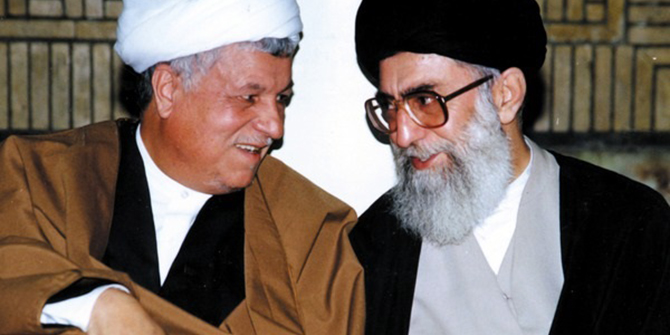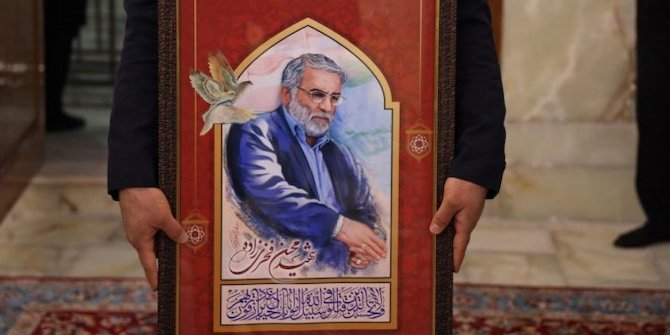by Adam Weinstein

On the eve of Ayatollah Hashemi Rafsanjani’s death, he was no longer a hardliner. But he wasn’t a reformist either. Many Western newspapers described him as ‘Iran’s ex-president’ in their elegies of him but his legacy dwarfs that characterisation. US policymakers should study both his life and the reaction to his death to understand the complexities of the Iranian nezam or system. At varying times and depending who you ask, Rafsanjani was a kingmaker, villain and tragic hero within that system. In his 2007 book, Iran: A People Interrupted, Professor Hamid Dabashi, a proponent of the revolution but critic of the resulting system described Rafsanjani as matching ‘Henry Kissinger’s politically criminal mind and Thatcher’s insidious statesmanship.’
When Ayatollah Khomeini died in the summer of 1989, it was Rafsanjani who advocated for the influential yet religiously unqualified (at the time) Khamenei to take on the role of Supreme Leader. In a speech before the Assembly of Experts, Rafsanjani recalled a time when he had lamented to Khomeini that nobody could fill his shoes when he died. According to Rafsanjani the aged Khomeini replied ‘of course we have Mr. Khamenei.’ A recording of the speech shows a dismayed Khamenei ascend to the podium amidst a cacophony of jeers and cheers and somberly respond ‘I’m against this anyway.’ Whatever his true desires, he was appointed to the position by his fellow clerics. Rafsanjani would forever be seated to Khamenei’s left in most public events symbolising his position as the second most powerful man in Iran.
Yet, this position did not secure him all the privileges one would expect. In 2009 a schism formed between the Supreme Leader and Rafsanjani over the fallout of the elections in which Mir-Hossein Moussavi lost to Ahmadinejad. Rafsanjani’s wife called on Iranians to protest in the streets if they felt the election was dishonest and they did. Rafsanjani himself delivered a Friday sermon stating the reformist demands for freedom of the press and political assembly. Later, in 2011, his daughter Faezeh Rafsanjani was arrested for protesting and spent time in prison. His son was also arrested. Even Rafsanjani’s own children were not immune from censorship through arrest. When President Ahmadinejad’s term ended in 2013, Rafsanjani was vetted – likely by Khamenei himself – from running for the office due to his post-2009 alignment with Green Movement figures and other reformists. Nevertheless, he revisited his role as kingmaker and was pivotal in Rouhani’s political success.
Rafsanjani inherited a war-ravaged Iran as President in 1989. He became known by some as the Sardar-e Sazandegi or Leader of Reconstruction. He needed to revitalise the economy and believed in the free market. Some have even criticised him as serving the bazaari or powerful merchant class. The economic woes of Iran during the Ahmadinejad era were arguably inherited from some of Rafsanjani’s liberal economic policies. He has also been widely accused of corruption and thievery. But outside of the domestic arena, Rafsanjani often appeared more pragmatic than other leaders of the revolutionary generation. He wanted to improve ties with the West and restore Iran’s place in the world. His commitment to the system was unimpeachable and he enjoyed the enviable ability to push back on the policies of hardliners – including the Supreme Leader – without facing serious consequences.
The biggest lesson that can be learned from Rafsanjani’s life is that even at the highest levels the Iranian system is not a monolith. The mullahs – a term for clerics that often carries a pejorative tone – may be united in their belief in the Islamic Republic but not in their vision for it. Secondly, Iran’s political landscape is defined by charismatic leaders rather than coherent political parties. For example, the Coalition of Hope – which scored major victories over hardliners in last year’s Majles elections – included the ostensibly hardline former head of the Ministry of Intelligence Mohammad Reyshahri. Contrary to the narratives of many US policy analysts, the office of the presidency in Iran is not merely one of a figurehead nor is the Supreme Leader entirely unbending. Figures outside of these two circles of power can and do wield immense influence over Iran’s foreign policy and domestic affairs. By definition, anyone who becomes president in Iran passed the scrutiny of the Supreme Leader and these include figures as divergent from one another as Rafsanjani, Khatami, Ahmadinejad and Rouhani. Rather than an impotent figurehead beholden to the Supreme Leader, the presidency in Iran is a litmus test through which the Supreme Leader can try out new policies but abdicate full responsibility if such policies lose public support. For example, it was Khatami rather than the system itself who faced the most scrutiny for failing to achieve his campaign promises.
This dynamic is especially true for foreign policy. The anti-West era of Ahmadinejad was as much a reaction to the snubbing of both Rafsanjani and Khatami by the Clinton administration as it was a reaction to domestic hardliner demands. In 1995 then President Rafsanjani granted two oil concessions to the US oil company Conoco. Israel feared such a deal would provide Tehran with money to use for terrorism. Under this pressure and in an attempt to lead the way in the fight against state-sponsored terrorism the Clinton administration signed two executive orders making oil investment in Iran illegal for US entities.
In 1999, the Clinton administration again had an opportunity of achieving détente with the relatively new President Khatami. However, President Clinton insisted the Islamic Republic claim responsibility for the bombing of the Khobar Towers in Saudi Arabia as seen in this declassified letter. This move forced Khatami to write a terse terse response in which he denied Iranian involvement and noted that the US had not only shot down a civilian Iran Air flight in 1988, but to add insult to injury the officers in charge were decorated. The downing of Iran Air 655 is to the Iranian national psyche what the hostage crisis of 1979 is to America. Rather than adopt a clean slate with Iran the Clinton administration pursued an all-or-nothing form of diplomacy.
The litmus test of both the pragmatists and reformists had failed and along came Ahmadinejad with a hardline approach. Despite his own hardline tendencies, Khamenei has been willing to grant presidents leeway to explore reforms so long as he could enjoy credit for any resulting successes and assign blame for failures. In the present era of Rouhani it was Rafsanjani who willingly acted as a shield for the risks the post-Khatami reformists took – including the Iran Deal. Rafsanjani has played the role of a revolutionary, a hardliner’s hardliner, a pragmatist and a tacit reformist. His household was an example of the complexity of womanhood in Iran as his wife and daughters covered themselves in the chador but rarely silenced their views. The corruption that is endemic in the Iranian system has tarnished his name. He has been accused of mass political murder and lauded for defending the nascent reformist movement. No single individual represents all aspects of the Nezam better than him. It is unknown how his departure will affect Rouhani’s reelection and domestic Iranian politics, which are unpredictable if nothing else. However, it is without doubt that US policymakers would be keen to study his life and play close attention to the shake-up that will inevitably result from his death.

Adam Weinstein is a third year law student and J.D. candidate at the Temple Beasley School of Law in Philadelphia, Pennsylvania where he focuses on developmental and international law. He also conducts research for the Think Tanks and Civil Societies Program at the Lauder Institute, University of Pennsylvania. His interests include the relationship of US foreign policy to development and security within the Middle East. He tweets at @AdamNoahWho and can also be reached at adam.weinstein@temple.edu.







1 Comments